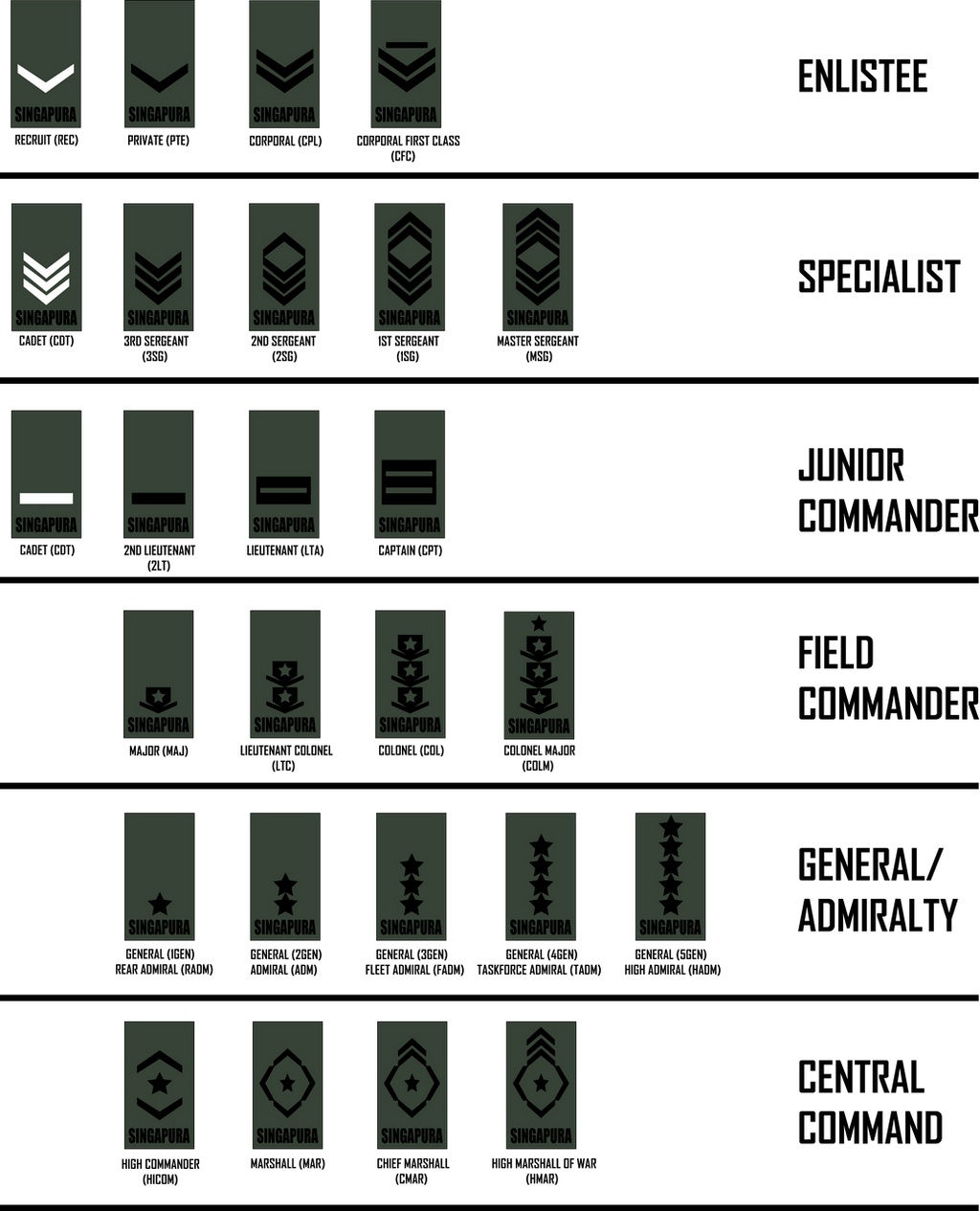HOME | DD
 Target21 — IRS Rank Structure
Target21 — IRS Rank Structure

#army #galactic #interstellar #irs #military #rank #ranks #republic #singapore #structure #ancerious
Published: 2018-11-13 11:05:03 +0000 UTC; Views: 9921; Favourites: 40; Downloads: 28
Redirect to original
Description
The entirety of the Armed Forces of the Interstellar Republic (AFIR)'s rank structure. While standard for most military organisations, other service branches such as SPANAVKOM may adopt a slightly different rank structures for their own operational requirements. AFIR ranks are split into six rank grades; Enlistee, Specialist, Junior Commander, Field Commander, General/Admiralty and Central Command.Enlistee Grade
Recruit
The lowest lifeform in AFIR. Usually given to fresh teenage conscripts who have just entered basic training to serve their two-year term in National Service.
Private
Given to Recruits who have completed basic training, Privates are still as equally powerless but are regarded as professional soldiers, serving as the backbone of the armed forces and the main unit of the squad.
Corporal
Privates who show leadership skills are promoted to Corporal at the recommendation of their superiors, acting as Fireteam leaders in charge of a small team of 5 soldiers.
Corporal First Class
Given to Corporals with exceptional leadership or have done exceptional deeds, the rank of Corporal First Class does not grant additional authority but increases prestige (and pay).
Specialist Grade
Cadet (Sergeant)
Selected from recruits who have done well and shown great leadership potential during basic training, these cadets will undergo additional training in a Specialist Academy to hone their leadership skills and learn squad-level tactics for 6 tough months.
3rd Sergeant
Cadets who graduated from Specialist Academy are immediately conferred this rank. 3rd Sergeants command a Section of 10 men and are the immediate bridge between the lower ranks and the higher command staff.
2nd Sergeant/1st Sergeant
2nd Sergeants coordinate with their five subordinate 3rd Sergeants to ensure the discipline and morale of the entire Platoon of 50 men. 2nd Sergeants who have done well in their tour of duty are promoted to 1st Sergeant, which while it does not increase their scope of authority, increases pay and prestige.
Master Sergeant
Master Sergeants are in charge of a Platoon of 50 men and delegate tasks from junior commanders to their 2nd and 1st Sergeants. They are officially in charge of the Platoon's morale, discipline and well being.
Junior Commander Grade
Cadet (Lieutenant)
Recruits who show even more exceptional abilities during basic training (especially those of the scholarly types with high academic qualifications) are sent to a Command Academy to undergo 9 months of mentally and physically gruelling training where they will learn squad and company-level tactics.
2nd Lieutenant
Conferred immediately after graduation, 2nd Lieutenants are usually placed in charge of half a Company (5 platoons) and are subordinate to the Lieutenant in charge of the full Company. 2nd Lieutenants are also the standard ranks for armored vehicle commanders and Aerospace pilots.
Lieutenant
In charge of an entire Company of 5 platoons and 500 men, Lieutenants have the responsibility to draft up their training schedules, their general welfare and tactical formation on the battlefield.
Captain
Lieutenants who have performed well and have decided to sign on as regulars will be promoted to Captain, with the monumental responsibility of taking charge of an entire brigade of 5000 men.
Field Commander Grade
Major
Majors take command of a Battalion which consists of 20 brigades and 100,000 men on the battlefield.
Lieutenant Colonel
Lieutenant Colonels are in charge of a Regiment which consists of 20 battalions and 2 million men. LTCs are the main commanders of either a region-sized defence garrison or a major planetary invasion force.
Colonel
Colonels command a Division which consists of 20 regiments and 40 million men. Division-sized units are usually responsible for continent-sized theatres.
Colonel-Major
Colonel-Majors are in charge of a single Planetary Army, which consists of 20 divisions and 800 million men, and command an entire planet's worth of troops or are placed directly in charge of large taskforces operating in foreign theatres of war.
General/Admiralty Grade
For the Regular Army, the differences between each level of General merely reflect war experience and seniority, as well as prestige and level of pay; Generals regardless of the number of stars will command a Sector's Garrison which consists of up to 10 Armies and 8 billion troops. Lower ranking Generals are usually placed in command of newly developing systems and are promoted accordingly as their own system grows in military manpower and strength.
For SPANAVKOM, the levels of Admiralty DO reflect differences in authority and the size of ships they command in addition to prestige and pay. Rear Admirals lead small fleets of ships up to 20 each, Admirals lead larger fleets and Fleet Admirals take command of entire taskforces worth 100 ships. Taskforce Admirals command armadas for large-scale intergalactic operations operating in a specific region of space, commanding up to 1000 ships. High Admirals are conferred to those who are experienced and well-proven in the field of battle, authorised to command even larger fleets and are given access to more specialised elite and prototype units and weapons.
Central Command Grade
High Commander
The High Commander is in charge of ALL military units in a Zone of 20-50 systems, commanding the entirety of its ground, air, space and oceanic forces with up to around 240 billion ground troops and 9000-10,000 ships. The High Commander is selected from one of the most tactically-gifted commanders among an early-developing colony's militia forces and is given the monumental responsibility of raising the aforementioned militia forces into a proper intergalactic army.
Marshall
Marshalls are in charge of a Service Branch's doctrinal, logistical and battlefield deployments on an intergalactic scale.
Chief Marshall
The most senior among the Marshalls take command of the Service in question. There are four services in AFIR - the Regular Army, SPANAVKOM, the Aerospace Forces and the Oceanic Defence Forces and each has a Chief Marshall in charge.
High Marshall of War
The High Marshall commands the entirety of AFIR and Central Command, reporting directly to the Autarchs and is responsible for the national security of the whole Republic.
























